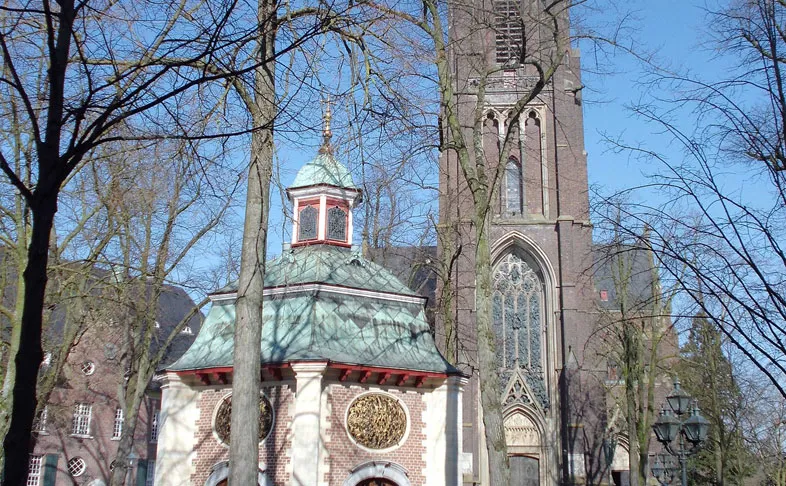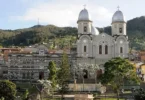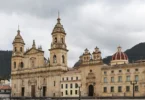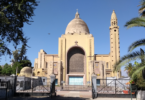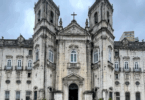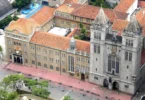
Introduction
Basilica of St. Mary, Kevelaer, Germany – The large pilgrimage church built between 1858 and 1864 was elevated to the status of papal basilica in 1923. The patronage of the “Assumption of Mary into Heaven” is intended to remind us what the goal of earthly pilgrimage is.
The painting by Friedrich Stummel takes up the idea of the “biblia pauperum”, which means: The pilgrim who is staying in the basilica and wants to rest internally directs his gaze at the paintings and can meditate on an event from the history of salvation, the history of the church the Christian life in the sacraments, from the Holy Scriptures or the liturgy.
The numerous ornaments do not want to be repeated. Your color style is not insignificantly influenced by Saint Chapelle in Paris.
The nave, southern and northern transepts were completed in 1864 according to the plans of the Cologne cathedral master builder Vincenz Statz, the more than 90 meter high tower only 20 years later.
The major pilgrim services take place in the basilica. Here the people of God experience themselves as if gathered together with Mary in prayer, as reported in the Acts of the Apostles.
As early as 1854, under President Johann Bernhard Brinkmann, who later became Bishop of Münster, an attempt was made to accommodate the pastoral requirements in Kevelaer by building confessional chapels.
It was only the plans of Vinzenz Statz from Cologne (1845 to 1854 second cathedral foreman of the Cologne cathedral building hut), who combined the confessional chapels with the construction of a large pilgrimage church into one complex, that made the start of an extensive building project come true in 1857/58.
Basilica of St. Mary, Kevelaer – The construction work was completed within six years, initially without the tower of the new pilgrimage church
History of The Basilica of St. Mary, Kevelaer

Basilica of St. Mary, Kevelaer – Drawing on the early Gothic style of French cathedrals and their German successors, a three-aisled, cross-shaped basilica with an extended choir adjoining the confessional chapels was built, to which two half-open spandrel chapels were attached.
Basilica of St. Mary, Kevelaer – The excavation work for the building, which was originally planned to be longer, began after difficult property negotiations on June 1, 1858, the foundation stone was laid by the Bishop of Münster, Johann Georg Müller, on August 15; the consecration took place in the presence of seven bishops on July 3, 1864. With the four-storey west tower with portal, large west opening, column-supported tower hall and needle-like pointed dome, which was added in 1883/84, the basilica received a striking conclusion and thus the cityscape of Kevelaer in terms of urban development a typical character.
As a result of the chancel being raised in conjunction with the closure of the lower choir window section, the cathedral choir was severely distorted in its original proportions in 1921, but was integrated into the context of the total work of art through the painting by the Stummel students Heinrich Holtmann and Karl Wenzel.
Basilica of St. Mary, Kevelaer – With the construction of an annex-like portal in 1933 on the southern arm of the transept, the overall artistic development of the basilica in its diversity and despite the incomplete painting of the nave and side aisles was essentially complete.
A new phase in the history of construction began with the Second World War. The confessional chapel on the left arm of the transept, which was destroyed by bombs, and the church, which was converted into a camp for foreigners after the end of the war, required great effort to repair the damage. Furthermore, according to the ideas of the Second Vatican Council, the liturgical-pastoral as well as the architectural-artistic conditions had to be taken into account.
Under the direction of the architect Günter Hagen from Cologne, work has been carried out on the repair of the building fabric since 1969. The opening of the lower chancel window, the creation of a crossing chancel and the removal of the so-called mill portal on the southern arm of the transept helped to bring Statz’s cathedral concept back into force, taking into account liturgical necessities.
In the same spirit, but in a modern style, Professor Kaldenhoff, Cologne, tried to glaze the choir windows and – using historical technology – restorer Walter Dorn from Buir/Cologne to the restoration of the paintings, which was almost completed by 1991.
Basilica of St. Mary, Kevelaer – Since the entire painting of the basilica was limited to the choir room, the choir pendentive chapels and the transept, the painting was carried out in 1988/91 according to old plans based on the Sainte-Chapelle in the Louvre in Paris. The figurative addition was dispensed with. The old stock was recreated ornamentally.
Architecture of The Basilica of St. Mary, Kevelaer

Architectural Style: Gothic Revival Architecture
Basilica of St. Mary, Kevelaer – The neo-Gothic furnishing of the pilgrimage church reached its climax towards the end of the 19th century in the colored painting of the architecture and design of the windows by Friedrich Stummel from Münster, who was working in Berlin at the time, and his workshop, the execution of which lasted into the 20th century.
The design, carried out by Stummel and his students in bright old colors, places the special feature of Mary in God’s plan of salvation in the foreground. Central themes are therefore the position of Mary and the biblical and ecclesiastical statements about her.
In accordance with the given architecture, all vault caps, wall pillars and spandrels, window reveals, columns and services, capitals and bases of the east half of the basilica are covered in the style of decorative painting of the highest artistic and technical standards. The individual representations in their course always point to the culmination, the coronation of Mary in the choir apse.
Basilica of St. Mary, Kevelaer – The paintings in the Antonius choir began in 1891, with the significant contribution of the then Pastor van Ackeren. The painting concept was based on the salvation-historical events in the Old and New Testaments and with special consideration of the commission and the position of the Blessed Mother on the medieval Biblia Pauperum.
The work continued on the Josefschor, the Marienchor and the Johanneschor, the high choir vault and the crossing until the first decade of the 20th century. This was followed by the right transept (1911 to 1912), the north transept (1914 to 1916) and, as a provisional conclusion, the high choir.
The rose window in the north transept was badly damaged in 1944.
The celebration altar was made in the newly created choir crossing in 1992 by Karl Hoss, Kevelaer, and consecrated on October 18 of the same year. The relics of St. Ursula and St. Thomas from the old altar from 1864.
The organ loft, from the founding period, with carrying consoles divided into several parts and provided with masks. The third console from the left shows the revised portrait of Bismarck. The large organ of the Marienbasilika with its valuable case, built in 1907 by the company Romanus Seifert, Kevelaer. With 128 sounding registers today, the basilica organ is one of the largest organ works in Europe.
Our Lady of Kevelaer

To give the history of the Shrine of Our Lady of Kevelaer in Northwestern Germany, we must begin by mentioning another Marian Shrine—Maria Consolatrix Afflictorum of Luxemburg. The Cathedral of Notre-Dame in Luxemburg City is home to the original miraculous statue of Our Lady under this title. She is the Patroness of Luxemburg, and copies of the image are to be found in nearly every major church in this tiny country. It was a printed copy of this image that became the main feature of the Shrine at Kevelaer—the second most visited Marian Shrine in Germany, after that located in Altötting.
It was near Christmas in 1641, during the confusion and hardship of the Thirty Years War, when a simple merchant named Hendrick Busman heard a mysterious call, as he stopped to pray at a roadside crucifix near the village of Kevelaer on the way from Weeze to Geldern (an area near the Dutch border). Hendrick Busman made the following statement under oath on February 13, 1642:
I am married to Mechel Schrouse who is about 50 years old. We supported ourselves with a small shop and this obliged me to travel to different places quite often. On one such journey around Christmas 1641 I was walking from Weeze on the road which passes near Kevelaer. At that time there was a wayside crucifix there. At this spot I heard a voice which said, “Build a little chapel for Me here.”
I was astonished and looked all round, but could see no one. I went on my way and took no more notice of the voice that first time. Seven or eight days later I came the same way and at the very same place I heard the same voice say the same words, for the second time. I heard the words, which came from the side of the crucifix, quite clearly.
This worried me considerably since I had very little money and lived frugally, and thought that because of this my wife would not agree to the building. However, I decided to save two or three coins daily and so gradually saved up the 100 Gilders necessary for the chapel.
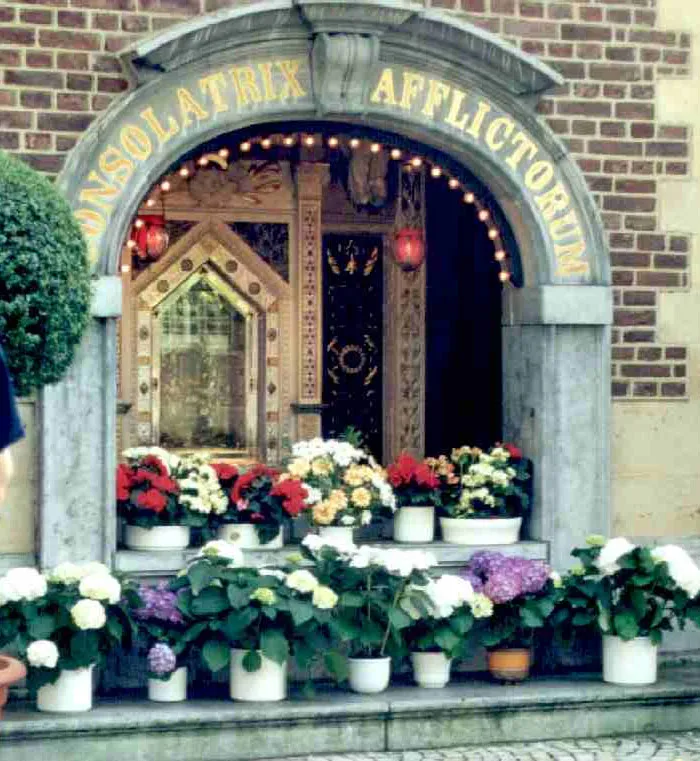
A few days later I again went that way and heard the same voice and the same words, so I stood still for quite a while, fearing that I was the victim of some deception. As I saw no sign of this I decided to stick to my resolution.
After this, about a month before the Feast of Pentecost, my wife Mechel had a nocturnal vision of a great light, and in the light she saw the chapel and a picture of the Blessed Mother of God, as she had seen it shortly before in the hands of two soldiers.
These soldiers had brought two paper pictures of Our Lady of Luxemburg to hand over to the lieutenant of the Mackewitz Company. The soldiers tried to sell her one of these—or a similar one—for their own profit, but were unsuccessful as the price was too high for her. So the pictures were handed over to the lieutenant.
Mechel told me about this vision because I had not seen it. I did not really believe it until two soldiers who had been patrolling at night and seen the light in my house, asked me during the day why I had a light so late at night, as I went early to bed like the other villagers, and had put out all the lights. Therefore I believed her story a bit more and sent her to the soldiers to look for the pictures.
The soldiers said they had already handed them over to the lieutenant who had been captured at the battle fought by General Lamboy, and he was now imprisoned in Kempen; she was told that she would have to wait until his release which occurred soon afterwards.
Since then I have managed to save up enough for the building of the chapel and I have found building materials with the willing help of the Parish Priest of Kevelaer. The building was completed during the week before the Church festival of Kevelaer, which falls on the Sunday before Pentecost.
During this time the lieutenant was released from prison. Mechel went to him and asked for one of the pictures, but he refused to sell it or give it to her, wondering why she was so eager to have it.
When Mechel explained why she wanted it so much, he immediately allowed her to choose one of the pictures. She brought it to me; and so I had a small board painted and I attached the picture to it so that it could be put into the little wayside shrine more easily.
History of Our Lady of Kevelaer
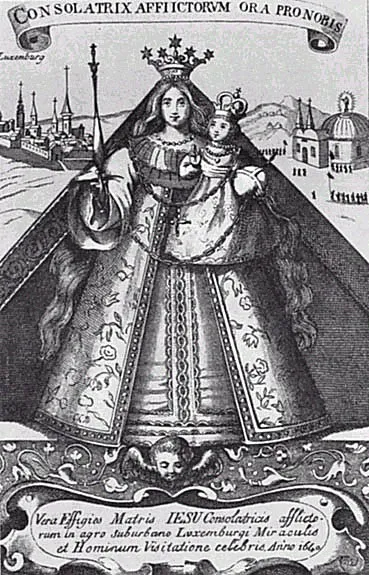
The picture was first kept in honor in the Carmelite monastery in Geldern; then in the Capuchin monastery. Hendrick Busman continues:
Then the Capuchin Fathers and their congregation wanted to take the picture in a procession to Kevelaer. For various reasons this was not done, but instead the parish priest of Kevelaer fetched the picture without special ceremonies on the evening of Saturday, May 31, 1642. The next day he placed it in the little chapel (shrine) which I had built according to my wife’s description following her nocturnal vision.
The same day a large crowd of people journeyed to the chapel from Geldern and other villages round about. Several miracles also took place which have been recorded faithfully.
Everything I have said here actually happened as stated and is the real truth. I Hendrick Busman have taken an oath that this is so, in the full knowledge of the consequences of the crime of perjury. I say this to the increase of the glory of God and of His Holy Virgin Mother. By taking this solemn oath, I declare that I will not revoke or change, anything I have said, either now or in the future. By promising this irrevocably I call God to be my witness and say: so help me God and all His Saints.
The picture which was enshrined has faded somewhat over the centuries. It depicts the image of Maria Consolatrix Afflictorum of Luxemburg—the crowned Madonna vested in a wide, open cloak, with the Baby Jesus, also crowned and holding a globe, seated on Her left arm; in Her right hand She holds a scepter. In the left background is pictured the city of Luxemburg; on the right is the old Chapel Shrine of Luxemburg, outside the city walls.
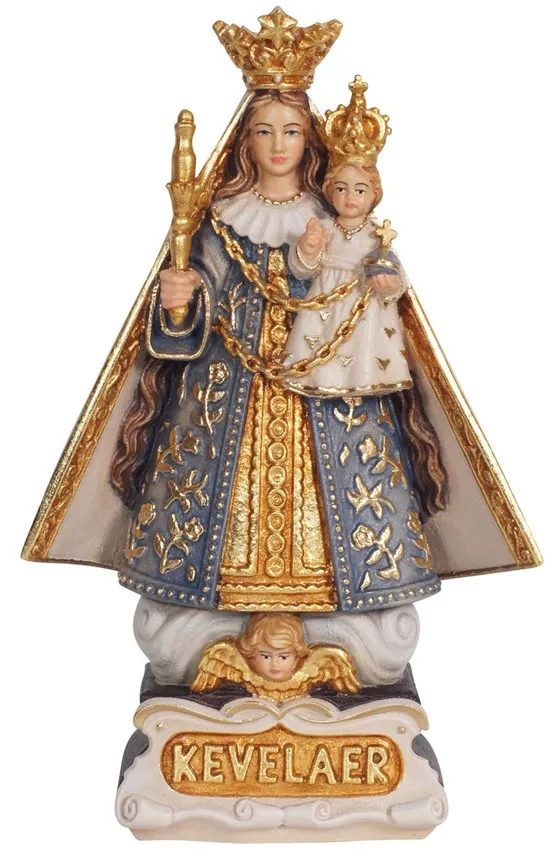
The Latin inscription under the picture is translated: True picture of the Mother of Jesus, Comforter of the Afflicted, situated just outside the city of Luxemburg, celebrated for miracles and the visits of pilgrims. In the year 1640.
For years the picture remained on the undecorated wooden board onto which Hendrick Busman had attached it. It received its first decoration in 1664 in the form of a gold-plated silver frame from the workshop of the goldsmith Laer of s’Hertogenbosch. Seventeen years later, on August 25, 1681, the Kaiser’s gentleman-in-waiting, the Duke of Oettingen, donated a large, artistically decorated silver plate into whose center the framed picture was set.
On the occasion of the 250th anniversary of the Shrine in 1892, the picture was given a gold crown of honor, as a gift from St. Peter’s in Rome. Faithful devotees of Our Lady donated precious stones, such as pearls and diamonds, as well as rings and bracelets, for the making of this crown—a masterpiece of the brothers Bausch of Kevelaer.
The people of Luxemburg also gave a gift to the Shrine of Kevelaer on the occasion of its 250th anniversary. It consists of two gold-plated silver rose branches which have been fixed over the picture. It decorates the tablet in whose center is the miraculous picture. The inscription in blue and white enamel reads: “A token of love from the mother to the daughter”—a reference to the two Shrines.
In 1654 a hexagonal chapel (Gnadenkapelle) was built around the wayside shrine that had been erected by Hendrick Busman twelve years earlier. This chapel has three doors in its southern side, leading to the interior of the chapel. On the northern side is a semicircular opening allowing pilgrims to see the picture from the outside of the chapel. Pilgrims can also follow a passage behind the chapel’s altar, to get a close view of the miraculous image (Gnadenbild).
In spite of the insecurity of the times of the Thirty Years War, the number of pilgrims increased from year to year. So the Vicar General of the diocese of Roermond organized the building of a pilgrims’ church which is now the Candle Chapel (Kerzenkapelle). The faith and sacrifice prevalent in those times is especially shown in the construction of this church during the war-torn years of 1643-45.
Processions have brought large candles to the chapel each year as gifts; the coat of arms below each candle show that some of these processions have been taking place for many years. The candle of Rees has a special place in the middle, in front of the Communion rail. The pilgrims of Rees were the first to come in an organized procession to Kevelaer, in 1643.
A large neo-Gothic church was built in 1858, although its tower, 90 meters in height, was not completed until 1884. In 1923 it was raised by Pope Pius XI to the rank of Minor Basilica. The interior is beautifully decorated by paintings, murals and windows—mostly the work of Friedrich Stummel.
The Basilica was damaged during the Second World War. Although it was saved from complete destruction, a bomb damaged some of the walls, windows and murals. In addition to this, after the end of the war it was turned into a shelter for foreigners on their way home. Eye-witnesses report that it was a sorry sight by the time it was released for Church services again, on August 28, 1945. Over the years repairs and restorations have returned the Basilica, to a great extent, to its original beauty—in spite of some typically ugly post-Conciliar modernizations.
Kevelaer itself was in the front line of the Second World War. At one point the population was ordered to evacuate. In their need the people fled to Our Lady. Some women began a Novena at the Gnadenkapelle. Their numbers increased each evening up to about one thousand. Still, the forced evacuation seemed inevitable.
The imprisonment of the caretaker of the Chapel and the bombing of the town only made the trust and prayers stronger and more zealous. Before the German soldiers retreated, the senseless (or should we not say, diabolical) order was given to blow up the Basilica. The inevitable result would have been the destruction of the Basilica, the Gnakenkapelle, and the Kerzenkapelle—but the explosion failed and all three buildings were saved. The prayers had been heard; the trust rewarded.

Feast Day - 8th September
Annual Feast Day of Our Lady of Kevelaer is held on 8th September.
Mass Time
Weekdays
- 10:00 am
Sundays
- 8:15 am
- 11:45 am
- 6:30 pm
Church Visiting Time
- Every Days : 11:00 am to 8:00 pm

Contact Info
Kapellenpl. 35,
47623 Kevelaer, Germany
Phone No.
Tel : +49 28 32 933 80
Accommodations
How to reach the Basilica
Weeze (NRN) Airport also known as Niederrhein Airport in Germany is the nearby airport to the Basilica.
Kevelaer Railway Station in the town of Kevelaer, North Rhine Westphalia, Germany is the nearby Train Station to the Basilica.

